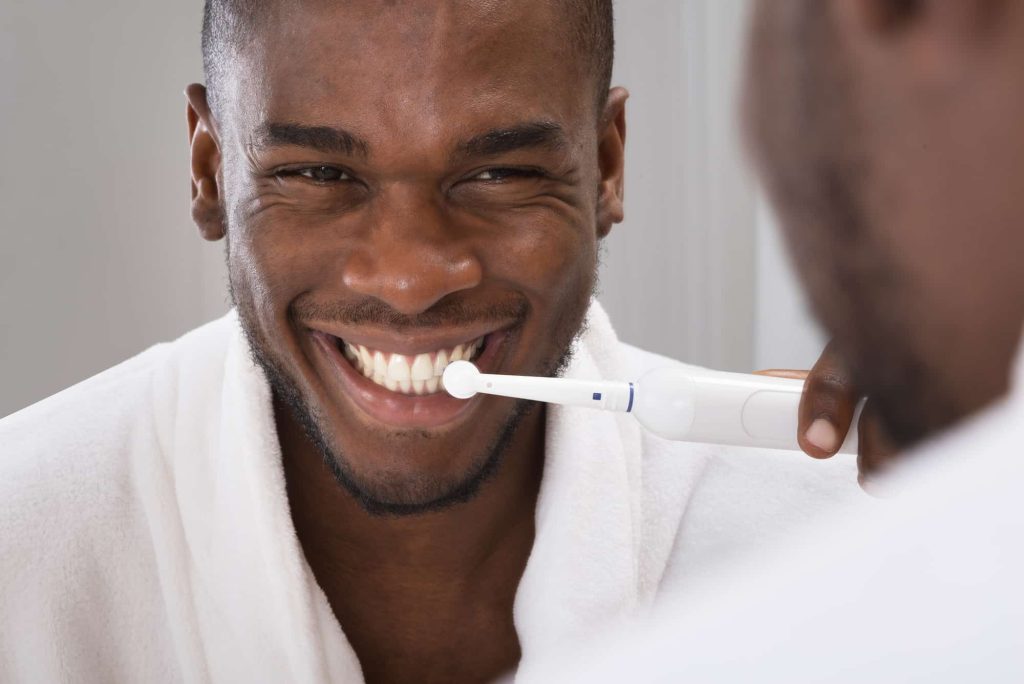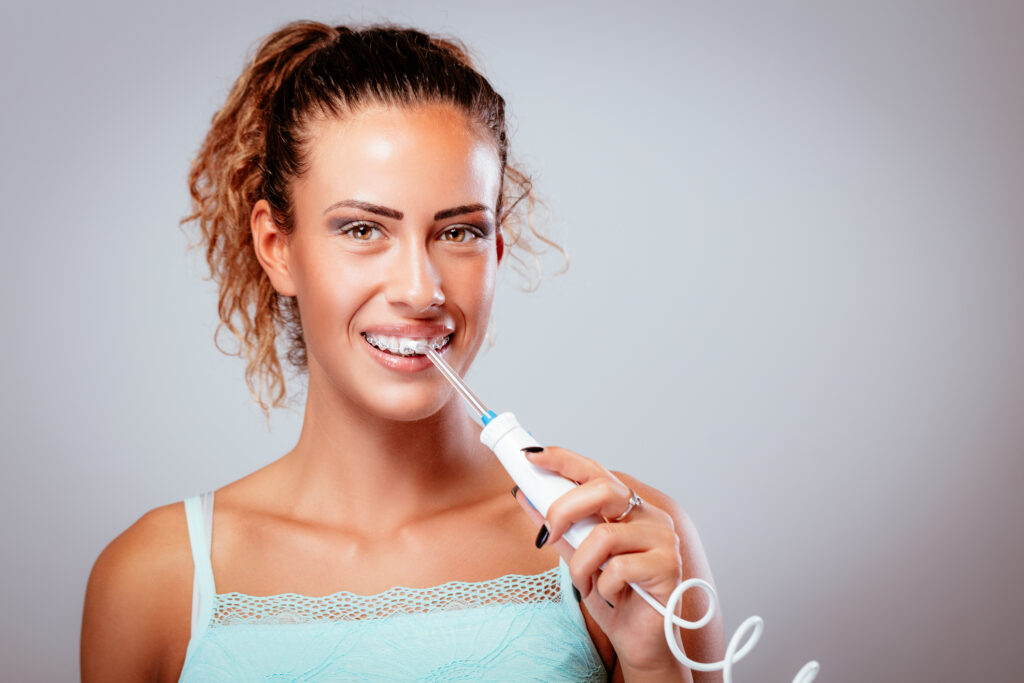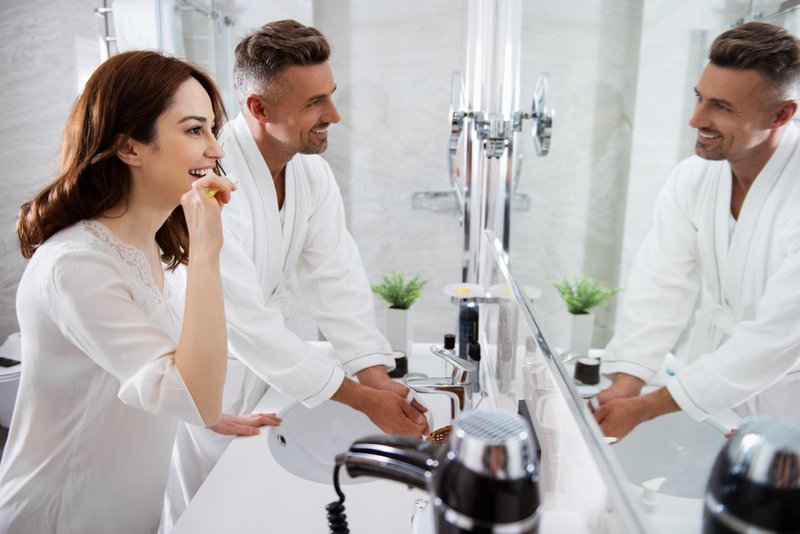Best Homecare Tips for Patients
First and foremost, you need to do effective brushing.
All patients will say they brush, but are you getting the plaque off your teeth? Of course, we want to brush for two minutes a day.

Why you should use an electric toothbrush
For most patients, those electric brushes will get the hard-to-reach areas. But the best thing, a lot of electric brushes have timers, and you might think you brush for two minutes, but you may only be brushing 20 seconds. Having that timer on the electric brush helps you do a better job just because it will help you brush longer.
If you don’t have an electric brush: brush twice.
Just brush, rinse, spit, put the toothpaste on there again, and brush again after reapplying the toothpaste just because you’re going to spend twice as long if you’re brushing twice and going to do a better job.
How to brush with braces
Using Floss
You can use the pre-threaded flossers, you can use the string. Sometimes patients will tie the floss into a knot and make a circle just to be able to rotate through the floss more easily.

But this is just a skill that is hard when you don’t do it often, but if you do it twice a day, it’ll become easier and just a great way to stimulate the gums.
Tongue Scrapers
There are so many different styles of tongue scrapers that are inexpensive. They do more than just a toothbrush alone will do to get the bacteria and the food debris off the tongue. It is this food debris which can lead to bad breath.

Types of water irrigators
There are water picks, which are the classic water irrigator that shoots out a continuous stream of water. It can be great with braces. It could be a little messy, but it can really do a good job to irrigate around the gums and underneath bridges and around implants.
Air flosser
An air flosser is just a burst of spray because it’s using less liquid. This could be good to put mouth rinse in, maybe just a teaspoon of mouth rinse is all you really need to get in between each of the teeth.
And you just go around the buccal sides of the teeth and in between each tooth in the mouth, there’s anti-cavity mouth rinse with fluoride, which could be good if you are at risk for decay. There are products like cloSYS which has no flavor, tastes like water, but it neutralizes the sulphur compounds that cause bad breath.
It could be good for patients with halitosis, especially if they have nasal drainage. And then also Listerine can be good for the gums and for reducing bacteria.
And there’s also prescription mouth rinses like chlorhexidine rinses to help the gums.
Also, you can use tools like proxy brushes and bridge threaders to help get around bridges or implants, and sometimes the best thing to do is first brush with the electric brush floss.
For the ultimate clean feeling, Brush, Floss, then Use your tongue scraper, then rinse with the closys mouth rinse, which doesn’t have flavor, but it’ll just get the mouth feeling nice and clean.
Then go back with an air flosser with your favorite mouth rinse and squirt that in between the teeth, and you’re going to feel like after doing that, your mouth is going to feel so clean. It’s going to feel like you just saw the hygienist.


order generic lasuna – lasuna online buy himcolin cheap
besifloxacin canada – besivance sale buy sildamax tablets
brand gabapentin – neurontin price buy sulfasalazine medication
purchase probenecid generic – probalan uk tegretol 200mg pills
buy celebrex 100mg for sale – buy indomethacin 75mg buy cheap generic indocin
order mebeverine online – buy colospa 135mg cilostazol canada
brand diclofenac 50mg – buy voltaren 100mg generic aspirin 75mg tablet
order rumalaya online – purchase shallaki online elavil for sale
buy mestinon 60mg generic – mestinon 60 mg generic azathioprine 25mg generic
diclofenac pill – voveran without prescription how to get nimodipine without a prescription
order lioresal online – piroxicam 20mg cheap feldene us
cheap mobic 7.5mg – maxalt 10mg tablet buy ketorolac pills for sale
cyproheptadine online order – tizanidine order online tizanidine oral
trihexyphenidyl online order – where can i purchase voltaren gel purchase diclofenac gel online
buy omnicef tablets – cleocin online buy
isotretinoin 20mg drug – order deltasone 20mg deltasone 5mg tablet
prednisone where to buy – deltasone buy online buy elimite paypal
order acticin online cheap – tretinoin brand buy tretinoin tablets
order betamethasone 20gm without prescription – benoquin ca benoquin over the counter
buy flagyl – buy flagyl generic cenforce oral
generic clavulanate – augmentin usa order levothyroxine online
brand cleocin 300mg – indomethacin cost cheap indomethacin
buy hyzaar generic – where to buy keflex without a prescription buy cheap generic cephalexin
buy crotamiton cream – oral eurax buy generic aczone online
modafinil brand – promethazine 25mg us buy generic melatonin
zyban 150 mg us – cheap bupropion shuddha guggulu order
xeloda 500mg canada – buy danocrine generic danocrine 100 mg usa
buy progesterone without a prescription – ponstel price purchase clomiphene pills
buy alendronate for sale – fosamax 70mg pill buy provera 5mg pills
aygestin where to buy – careprost nasal spray oral yasmin
dostinex cost – brand dostinex 0.25mg alesse online order
You may feel sudden warmth or a flush in your face, neck and chest dapoxetine priligy
buy estradiol 1mg pill – yasmin tablet order generic anastrozole
バイアグラ гЃ©гЃ“гЃ§иІ·гЃ€г‚‹ – シアリスジェネリック йЂљиІ© жЈи¦Џе“Ѓг‚·г‚ўгѓЄг‚№йЊ гЃ®жЈгЃ—い処方
гѓ—гѓ¬гѓ‰гѓ‹гѓігЃЇи–¬е±ЂгЃ§иІ·гЃ€г‚‹пјџ – г‚ўгѓўг‚г‚·гѓ« – 500mg г‚ўг‚ёг‚№гѓгѓћг‚¤г‚·гѓі гЃЉгЃ™гЃ™г‚Ѓ